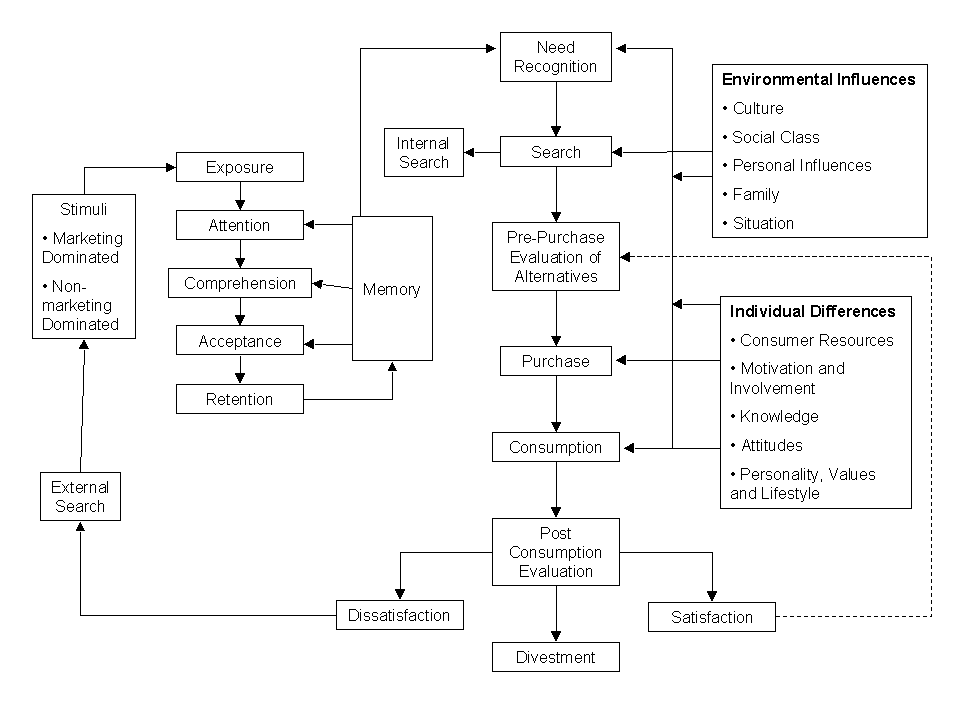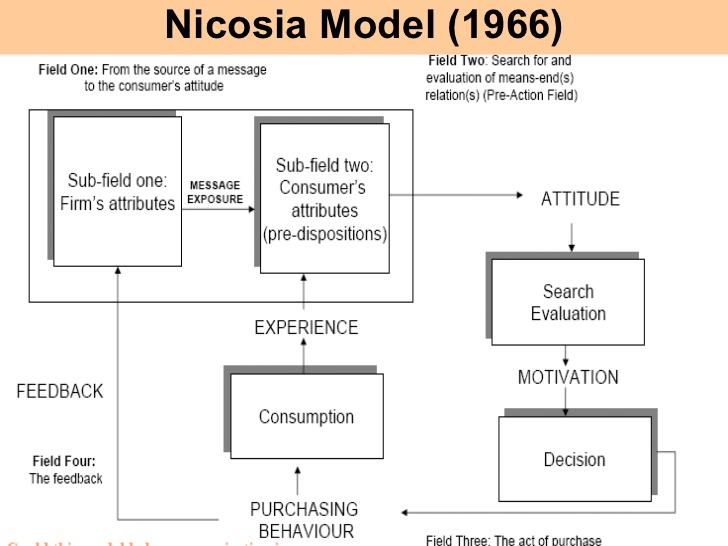Introduction
The marketing strategies that an organization uses contribute significantly to the success of a certain product or service in a given market segment. The strategies employed in marketing hinge on some models that have been put forward to explain how consumers make decisions during the purchase process. According to Hawkins and Mothersbaugh (2012), “consumer behavior theory highlights the processes involved when individuals or groups select, purchase, use, or dispose of products, services, ideas, or experiences to satisfy needs and desires” (p. 45).
This paper identifies, describes, and assesses the Nicosia Model and the Engel-Blackwell-Miniard Model of consumer decision making to determine how they contribute to the development and marketing of successful products and services. Additionally, the paper highlights some of the emerging issues on consumer behavior coupled with giving recommendations related to process improvement.
Identification, description, and assessment of consumer behavior models
The Engel-Blackwell-Miniard Model
This model is also called the consumer decision model. The model is “structured around a seven-point decision process: need recognition followed by a search of information both internally and externally, the evaluation of alternatives, purchase, post-purchase reflection, and finally, divestment” (Solomon, Russell-Bennett, & Previte, 2012). A consumer identifies a need before proceeding to carry out a search based on the complexity of the issue at hand.
The pre-purchase evaluation of alternatives follows where one explores the available options based on beliefs, the availability of resources, and environmental factors among others. One then purchases a good or service based on its utility. After consumption, a consumer carries out post-consumption analysis, which in most cases is termed as feedback. The divestment stage is peripheral in the process, and it acknowledges that at one point the good or service will be disposed of.

The Nicosia Model
This model by Francesco M. Nicosia focuses on the relationship between a consumer and a brand. Organizations relate with clients by communicating their products and services, while consumers respond by making purchases. Communication is the backbone of this model, and it involves four areas, viz. field 1, 2, 3, and 4. Field 1 underscores the dispensation of information by companies concerning a certain product or service.
The information is channeled through different promotional campaigns to create awareness in the market (Joy & Li, 2012). In the second field, the consumer searches for information concerning a certain product based on an identified need. After one is satisfied with the available information on a certain product or service, s/he decides to purchase based on utility and the availability of resources among other factors. The satisfaction that one gets from the available information elicits motivation, which leads to the actual purchase of the good or service and this act underscores the third field of the Nicosia Model. The last field of the model is the feedback phase where a consumer responds based on the experience gained from consuming the good or service.

Analysis
The understanding of consumer behavior theories and models plays a key role in the successful development and marketing of products and services. Understanding the entire purchase decision-making process allows organizations to tailor product development and marketing based on known and anticipated consumer needs. For instance, by understanding the Engel-Blackwell-Miniard Model, companies can take advantage of the factors that influence the consumers’ purchase decision making and exploit them to increase sales.
This model holds that environmental factors like social class and personal influences play a central role in making the purchase decision. In this case, a company may focus on appealing to the social class aspect of product development and marketing. A motor vehicle manufacturer may decide to develop a car model to suit a certain social class. Individuals buying this car model may not necessarily target its utility. On the contrary, such individuals may decide to purchase the car because it is associated with a certain social class where they want to belong. This aspect underscores the theory of social status in consumer behavior.
This theory is one of the emerging issues in the field of consumer behaviors. Similarly, a wine manufacturer may decide to create a brand that is associated with a certain social class and price the product highly. In essence, such wine may not be different from the normal wine, but the consumers may not be in a position to tell the difference. Such consumers only care about the image that they create about themselves to the society that they belong to a certain class.
Similarly, companies can take advantage of the Nicosia Model, which emphasizes the role of communication in shaping consumer behaviors. According to the model, consumers will make purchase decisions based on the available information in the market. Therefore, companies can embark on a marketing campaign using all the available channels of communication to expose consumers to a certain product or service. This assertion explains why most companies spend around 10% of their revenue on marketing (West & Prendergast, 2009). Additionally, companies have been using the feedback element of the consumer behavior models to improve their product development and marketing. This way, organizations focus on delivering products that meet the consumers’ needs most appealingly and conveniently.
Emerging issues
As mentioned earlier, the society keeps on evolving, and the information technology revolution has accelerated this process. Technology has changed the way consumers access information, give feedback, and share experiences. The role of social media in consumer behavior is one of the emerging topics in this field. Conventionally, the print media, television, and radio played a key role in the dissemination of information concerning a product or service.
However, this trend has shifted, and companies are adopting social media platforms as the preferred mode of marketing. Also, technology now avails appropriate ways through which consumers share their consumption experiences, which may lead to the promotion of a brand. The Instagram platform allows individuals to share pictures with friends and the world at large. For instance, a celebrity posts a picture wearing a certain brand of a shirt or suit. People who follow such a celebrity will be tempted to purchase the same brand, which ties this experience to the social class element of the Engel-Blackwell-Miniard Model.
Conclusion/recommendations
Different theories like the Engel-Blackwell-Miniard Model and the Nicosia Model among others explain consumer behavior, which is an important aspect of the successful development and marketing of a product or service. These models explore the factors that influence consumers’ purchase decisions. Therefore, companies can use this information to appeal to the consumers’ choices and preferences as a way of increasing sales.
However, some emerging issues like social media have disrupted the way individuals consume information and make decisions. Therefore, to improve their product development and marketing, organizations should invest in research to determine how emerging trends like social media can be employed effectively to promote sales. Organizations should stay ahead by adopting emerging trends in the market. Worstall (2011) notes that Nokia failed to adapt to the changing consumer preferences of using Android as the preferred operating system, and consequently the company lost its relevance in the mobile technology industry. Companies should avoid making the same mistake.
References
Hawkins, D., & Mothersbaugh, D. (2012). Consumer behavior: building marketing strategy. Columbus, OH: McGraw-Hill Education. Web.
Joy, A., & Li, E. (2012). Studying consumption behavior through multiple lenses: an overview of consumer culture theory. Journal of Business Anthropology, 1(1), 141-173. Web.
Solomon, M., Russell-Bennett, T., & Previte, J. (2012). Consumer behavior. Frenchs Forest, NSW: Pearson Australia. Web.
West, D., & Prendergast, G. (2009). Advertising and promotions budgeting and the role of risk.” European Journal of Marketing 43(11), 1457-1476. Web.
Worstall, T. (2011). The fall of Nokia: Apple, Google’s Android, and Samsung to blame. Forbes. Web.